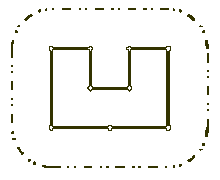HDU 1348 Wall
Problem Description
Once upon a time there was a greedy King who ordered his chief Architect to build a wall around the King's castle. The King was so greedy, that he would not listen to his Architect's proposals to build a beautiful brick wall with a perfect shape and nice tall towers. Instead, he ordered to build the wall around the whole castle using the least amount of stone and labor, but demanded that the wall should not come closer to the castle than a certain distance. If the King finds that the Architect has used more resources to build the wall than it was absolutely necessary to satisfy those requirements, then the Architect will loose his head. Moreover, he demanded Architect to introduce at once a plan of the wall listing the exact amount of resources that are needed to build the wall.
Your task is to help poor Architect to save his head, by writing a program that will find the minimum possible length of the wall that he could build around the castle to satisfy King's requirements.

The task is somewhat simplified by the fact, that the King's castle has a polygonal shape and is situated on a flat ground. The Architect has already established a Cartesian coordinate system and has precisely measured the coordinates of all castle's vertices in feet.
Your task is to help poor Architect to save his head, by writing a program that will find the minimum possible length of the wall that he could build around the castle to satisfy King's requirements.

The task is somewhat simplified by the fact, that the King's castle has a polygonal shape and is situated on a flat ground. The Architect has already established a Cartesian coordinate system and has precisely measured the coordinates of all castle's vertices in feet.
Input
The
first line of the input file contains two integer numbers N and L
separated by a space. N (3 <= N <= 1000) is the number of vertices
in the King's castle, and L (1 <= L <= 1000) is the minimal
number of feet that King allows for the wall to come close to the
castle.
Next N lines describe coordinates of castle's vertices in a clockwise order. Each line contains two integer numbers Xi and Yi separated by a space (-10000 <= Xi, Yi <= 10000) that represent the coordinates of ith vertex. All vertices are different and the sides of the castle do not intersect anywhere except for vertices.
Next N lines describe coordinates of castle's vertices in a clockwise order. Each line contains two integer numbers Xi and Yi separated by a space (-10000 <= Xi, Yi <= 10000) that represent the coordinates of ith vertex. All vertices are different and the sides of the castle do not intersect anywhere except for vertices.
Output
Write
to the output file the single number that represents the minimal
possible length of the wall in feet that could be built around the
castle to satisfy King's requirements. You must present the integer
number of feet to the King, because the floating numbers are not
invented yet. However, you must round the result in such a way, that it
is accurate to 8 inches (1 foot is equal to 12 inches), since the King
will not tolerate larger error in the estimates.
This problem contains multiple test cases!
The first line of a multiple input is an integer N, then a blank line followed by N input blocks. Each input block is in the format indicated in the problem description. There is a blank line between input blocks.
The output format consists of N output blocks. There is a blank line between output blocks.
This problem contains multiple test cases!
The first line of a multiple input is an integer N, then a blank line followed by N input blocks. Each input block is in the format indicated in the problem description. There is a blank line between input blocks.
The output format consists of N output blocks. There is a blank line between output blocks.
Sample Input
1
9 100
200 400
300 400
300 300
400 300
400 400
500 400
500 200
350 200
200 200
Sample Output
1628
题解:
这题求解顺序可以乱搞,我选的极角序,直接像斜率优化中维护凸壳一样求凸包即可.
然后答案为凸包周长+半径为L的圆的周长(为什么?看看样例的图就知道了)
1 #include <algorithm> 2 #include <iostream> 3 #include <cstdlib> 4 #include <cstring> 5 #include <cstdio> 6 #include <cmath> 7 #define PI 3.1415926535 8 using namespace std; 9 const int N=1505; 10 int n; 11 struct P{ 12 int x,y; 13 P(){}; 14 P(int _x,int _y){x=_x;y=_y;} 15 int operator *(P A)const{ 16 return x*A.y-A.x*y; 17 } 18 P operator -(P A)const{ 19 return P(x-A.x,y-A.y); 20 } 21 }a[N]; 22 int dis(P i,P j){ 23 return (i.x-j.x)*(i.x-j.x)+(i.y-j.y)*(i.y-j.y); 24 } 25 int across(P C,P A,P B){ 26 return (A-C)*(B-C); 27 } 28 bool comp(P A,P B){ 29 int tmp=across(a[1],A,B); 30 if(tmp>0)return true; 31 if(tmp==0 && dis(a[1],A)<dis(a[1],B))return true; 32 return false; 33 } 34 int top=0;P st[N]; 35 bool check(P A,P B,P C){ 36 int tmp=across(A,B,C); 37 return tmp>0; 38 } 39 int jar(int n){ 40 top=0; 41 if(n==0)return 0;st[++top]=a[1]; 42 if(n==1)return 1;st[++top]=a[2]; 43 if(n==2)return 2; 44 for(int i=3;i<=n;i++){ 45 while(top>=2 && check(a[i],st[top],st[top-1])) 46 top--; 47 st[++top]=a[i]; 48 } 49 return top; 50 } 51 int findit(){ 52 int ret=1; 53 for(int i=2;i<=n;i++){ 54 if(a[ret].y>a[i].y)ret=i; 55 else if(a[ret].y==a[i].y && a[ret].x>a[i].x)ret=i; 56 } 57 return ret; 58 } 59 void work() 60 { 61 int L; 62 scanf("%d%d",&n,&L); 63 for(int i=1;i<=n;i++){ 64 scanf("%d%d",&a[i].x,&a[i].y); 65 } 66 int sta=findit(); 67 swap(a[sta],a[1]); 68 sort(a+2,a+n+1,comp); 69 int cnt=jar(n); 70 double ans=0; 71 for(int i=2;i<=cnt;i++){ 72 ans+=sqrt(dis(st[i],st[i-1])); 73 } 74 if(cnt>=3)ans+=sqrt(dis(st[cnt],st[1])); 75 ans+=2*L*PI; 76 printf("%.lf\n",ans); 77 } 78 79 int main() 80 { 81 82 int T; 83 scanf("%d",&T); 84 while(T--){ 85 work(); 86 if(T)printf("\n"); 87 } 88 return 0; 89 }


